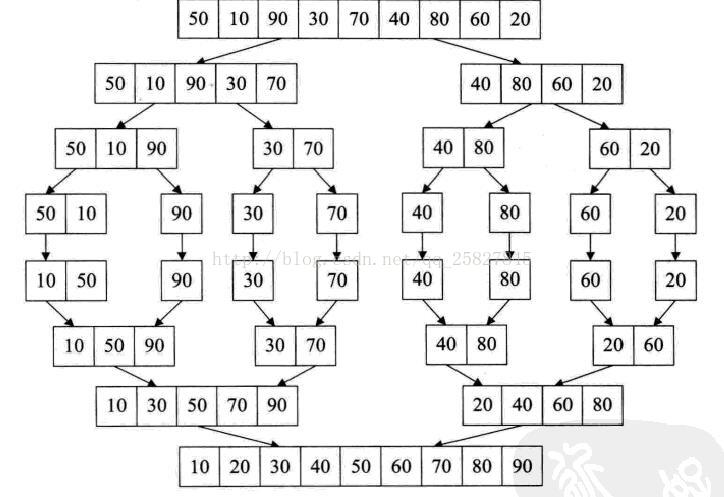https://blog.csdn.net/qq_25827845/article/details/70994874
1.总体思想,就是分治

关于时间复杂度我一直都很迷,但是看了实现之后,就明白了,merge的时间复杂度是O(n)因为,有O(logn)层吧,所以时间复杂度就是两者相乘。
#还是不理解,抽象,先死记一下。
因为在merge的时候需要创建一个新数组来保存有序的排列,所以空间复杂度为O(n)。
import java.util.Arrays; public class Test { // 归并排序的实现 public static void main(String[] args) { int[] nums = { 2, 7, 8, 3, 1, 6, 9, 0, 5, 4, -3}; System.out.println(Arrays.toString(nums)); sort(nums, 0, nums.length-1); System.out.println(Arrays.toString(nums)); } /** * 归并排序 * 简介:将两个(或两个以上)有序表合并成一个新的有序表 即把待排序序列分为若干个子序列, * 每个子序列是有序的。然后再把有序子序列合并为整体有序序列 * 时间复杂度为O(nlogn) * 稳定排序方式 * @param nums 待排序数组 * @return 输出有序数组 */ public static int[] sort(int[] nums, int low, int high){ int mid = (low+high)/2; if(low<high){ // 处理左边 sort(nums, low, mid); // 处理右边 sort(nums, mid+1, high); // 左右归并 merge(nums, low, mid, high); } return nums; } private static void merge(int[] nums, int low, int mid, int high) { // 定义一个辅助数组,所以该算法的空间复杂度为O(n) int[] temp = new int[high-low+1]; int i = low; int j = mid+1; int k = 0; // 找出较小值元素放入temp数组中 while(i<=mid && j<=high){ if(nums[i]<=nums[j]) temp[k++] = nums[i++]; else temp[k++] = nums[j++]; } // 处理较长部分 while(i<=mid){ temp[k++] = nums[i++]; } while(j<=high){ temp[k++] = nums[j++]; } // 使用temp中的元素覆盖nums中元素 for (int k2 = 0; k2 < temp.length; k2++) { nums[k2+low] = temp[k2]; } } }